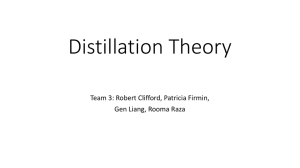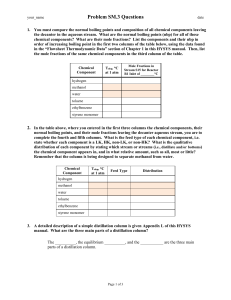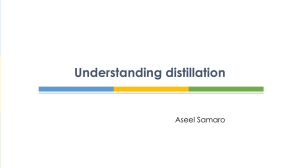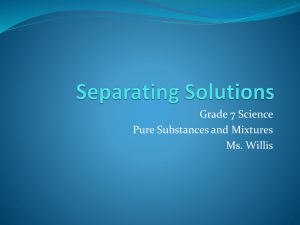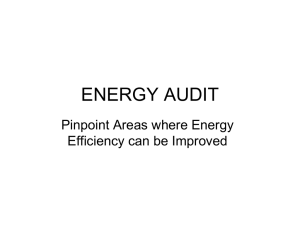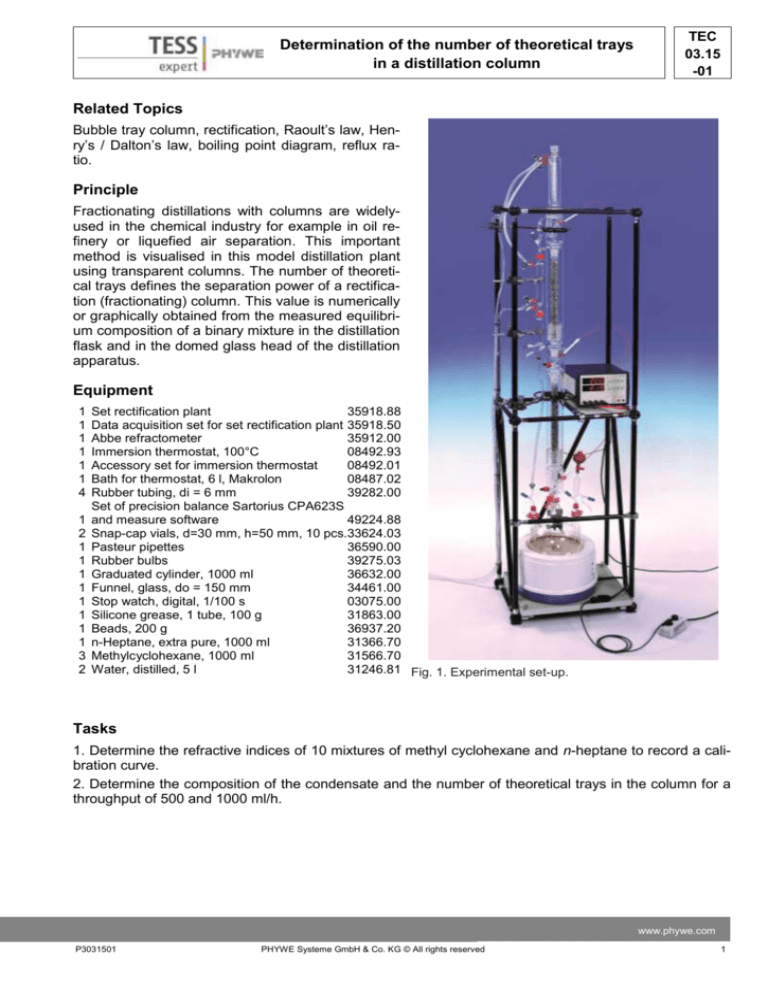
Determination of the number of theoretical trays
in a distillation column
TEC
03.15
-01
Related Topics
Bubble tray column, rectification, Raoult’s law, Henry’s / Dalton’s law, boiling point diagram, reflux ratio.
Principle
Fractionating distillations with columns are widelyused in the chemical industry for example in oil refinery or liquefied air separation. This important
method is visualised in this model distillation plant
using transparent columns. The number of theoretical trays defines the separation power of a rectification (fractionating) column. This value is numerically
or graphically obtained from the measured equilibrium composition of a binary mixture in the distillation
flask and in the domed glass head of the distillation
apparatus.
Equipment
1
1
1
1
1
1
4
1
2
1
1
1
1
1
1
1
1
3
2
Set rectification plant
35918.88
Data acquisition set for set rectification plant 35918.50
Abbe refractometer
35912.00
Immersion thermostat, 100°C
08492.93
Accessory set for immersion thermostat
08492.01
Bath for thermostat, 6 l, Makrolon
08487.02
Rubber tubing, di = 6 mm
39282.00
Set of precision balance Sartorius CPA623S
and measure software
49224.88
Snap-cap vials, d=30 mm, h=50 mm, 10 pcs.33624.03
Pasteur pipettes
36590.00
Rubber bulbs
39275.03
Graduated cylinder, 1000 ml
36632.00
Funnel, glass, do = 150 mm
34461.00
Stop watch, digital, 1/100 s
03075.00
Silicone grease, 1 tube, 100 g
31863.00
Beads, 200 g
36937.20
n-Heptane, extra pure, 1000 ml
31366.70
Methylcyclohexane, 1000 ml
31566.70
Water, distilled, 5 l
31246.81 Fig. 1. Experimental set-up.
Tasks
1. Determine the refractive indices of 10 mixtures of methyl cyclohexane and n-heptane to record a calibration curve.
2. Determine the composition of the condensate and the number of theoretical trays in the column for a
throughput of 500 and 1000 ml/h.
www.phywe.com
P3031501
PHYWE Systeme GmbH & Co. KG © All rights reserved
1
TEC
03.15
-01
Determination of the number of theoretical trays
in a distillation column
Set-up and Procedure
1. Recording the calibration curve
Connect the refractometer to the immersion thermostat and temperature equilibrate it to 25 °C. Prepare
the mixtures 10 mixtures of methyl cyclohexane and n-heptane with substance ratios (mole fractions)
from 0 to 1 and with step width of approximately 0.1 as listed in Table 1 and immediately measure the refractive indices. Plot the refractive indices against their mole fractions. The respective compositions of
the mixtures can be graphically or numerically determined from the slope of the regression line (Fig. 3).
Do not discard the mixtures; pour all of them into the distillation flask.
Table 1: Mixtures for the calibration curve
No.
1
nMethylHeptane/g cyclohexane/g
15.000
0.000
Mole frac- Mole fraction
tion x of
x of Methyln-heptane cyclohexane
1
0
2
13.302
1.664
0.88679
0.11321
3
11.653
3.280
0.77685
0.22315
4
10.403
4.505
0.69351
0.30649
5
8.665
6.208
0.57764
0.42236
6
6.980
7.858
0.46533
0.53467
7
5.346
9.459
0.35643
0.64357
8
3.762
11.012
0.25079
0.74921
9
2.681
12.071
0.1787
0.8213
10
1.323
13.402
0.08817
0.91183
11
0.000
15.000
0
1
Fig. 2: Calibration curve
2. Performing the measurements
Set up the experiment as shown in Figs. 1 and 2.
Add further quantities of methyl cyclohexane and n-heptane to the combined mixtures in the distillation
flask, so that 750 ml of n-heptane and 3000 ml of methyl cyclohexane are present in the flask. Put in a
few boiling beads. Adjust the glass tube for the recirculation of condensate from the separatory funnel in
such a manner that it ends at least 5 cm below the level of the liquid in the flask, so that vapour cannot
flow up through it. Check the correctness and tightness of the apparatus, turn on the cooling water, and
set the steam splitter to reflux. Set the heating hood to III and the power regulator to 8. At the onset of
condensation in the reflux condenser, turn the power regulator setting down to 3.5. After two to three
hours of distillation under total reflux, switch the steam splitter over to withdrawal and collect the distillate
in the separatory funnel. Use the stop watch to determine the time required for 10 ml of condensate to
collect and convert this to ml/h. The value should lie between 400 and 600 ml/h. If readjustment is necessary, wait for 30 minutes at total reflux before taking the next sample. When the desired throughput
has been achieved, switch back to total reflux for 30 minutes until thermal equilibrium has again established. Subsequent to this, begin taking samples of the condensate.
Note:
Only small quantities are required for the determination of the refractive index. The removal of larger
quantities of condensate disturbs the equilibrium in the column for a relatively long time, since total reflux
is not possible during sample-taking! To take a sample, open the PTFE-valve above the distillate condenser to collect distillate in the separatory funnel. Check, if the valve of the separatory funnel leading
the distillate through the PVC-tubing back to the flask is closed. As soon as enough condensate has accumulated close the valve above the distillate condenser. Collect the distillate by opening the appropriate
2
PHYWE Systeme GmbH & Co. KG © All rights reserved
P3031501
Determination of the number of theoretical trays
in a distillation column
TEC
03.15
-01
PTFE-valve of the separatory funnel and immediately determine the refractive index of the condensate.
After that, open the other valve of the separatory funnel to return the rest of the distillate to the flask. Repeat this procedure at 15-minute intervals until the refractive index remains nearly constant. When this is
the case, take a sample from the distillation flask via the sampler with the aid of the pipettor.
Let this sample cool in the sampler (both cocks closed), then drain it into a beaker via the outer cock and
measure its refractive index.
To set the device for a higher throughput, turn the power regulator up by half a setting, and again wait for
1 to 2 hours. The throughput should now be 800 to 1200 ml/h, if it is so, proceed as for the first setting.
The results are two refractive indices for each distillation rate, which allow the composition of the liquid in
the distillation flask and of the steam in the column head to be determined.
Fig. 3: Distillation apparatus, schematic diagram
www.phywe.com
P3031501
PHYWE Systeme GmbH & Co. KG © All rights reserved
3
TEC
03.15
-01
Determination of the number of theoretical trays
in a distillation column
Theory and evaluation
Rectification is a distillation process in which, for the purpose of an improved separation, part of the condensate flows back down against the vapour and so participates in substance and heat exchange with
the vapour. The mixture to be separated is heated in an evaporating vessel until it begins to boil. During
boiling, the temperature continually increases because the composition of the mixture changes. A temperature gradient is formed in the column. This gradient ranges from a temperature T0,A below the boiling
point of the substance with the highest boiling point A in the evaporating vessel up to the boiling point
temperature T0,B of B at the head of the column. On evaporating the liquid, a vapour is formed which is
enriched with the more volatile substance B. This vapour is then partially condensed on the the first column tray, as this is at a lower temperature. This liberates condensation enthalpy, which heats the condensate present there. New vapour is evolved, which is again enriched with B and flows to the second
tray, on which the same procedure is repeated. An exchange of energy (condensation enthalpy, enthalpy
of vaporization) takes place at each tray and, alongside this, an exchange of substances. We are viewing the behaviour under the assumptions that we have „ideal trays“ and „total refluxing“, whereby an ideal tray is to be understood to be one at which the backflow of liquid is in equilibrium with the rising vapour. With total refluxing, no distillate is removed from the top of the column. All condensate returns back
down the column.
For the partial pressure pA and pB of two components A and B in the vapour space above a liquid binary
mixture and with ideal behaviour, the following is valid according to Raoult’s law:
𝑝𝐴 = 𝑃𝐴 ∙ 𝑥𝐴 𝑝𝐵 = 𝑃𝐵 ∙ 𝑥𝐵
(1)
where pA and pB are the vapour pressures of the pure components, and xA and xB the mole fractions in
the liquid phase. For a binary mixture the following is valid:
𝑥𝐵 = 1 − 𝑥𝐴
(2)
and the ratio of the partial pressures in the vapour space can be formulated as:
𝑝𝐴 𝑃𝐴
𝑥𝐴
=
∙
𝑝𝐵 𝑃𝐵 1 − 𝑥𝐴
(3)
According to Dalton’s law, the partial pressures pA and pB with the total pressure p are linked over the
mole fractions yA and yB of the two components in the gas phase:
𝑝𝐴 = 𝑝 ∙ 𝑦𝐴
(4.1)
𝑝𝐵 = 𝑝 ∙ 𝑦𝐵 = p(1 − 𝑦𝐴 )
(4.2)
By substituting in (3) the following is obtained:
𝑦𝐴
𝑃𝐴
𝑥𝐴
=
∙
1 − 𝑦𝐴 𝑃𝐵 1 − 𝑥𝐴
4
(5)
PHYWE Systeme GmbH & Co. KG © All rights reserved
P3031501
TEC
03.15
-01
Determination of the number of theoretical trays
in a distillation column
If no indices are given, x and y refer to the more volatile components. For the relationship of the vapour
pressures of the pure components, the relative volatility is used:
α=
𝑃𝐴
𝑃𝐵
(6)
Equation (5) now becomes
𝑦𝐴
𝑥𝐴
= α∙
1 − 𝑦𝐴
1 − 𝑥𝐴
(7)
and after rearranging
y=
α∙x
1 + (α − 1) ∙ x
(8)
This equation can be used to construct an equilibrium diagram (mole fraction y of the more volatile
component in the gas phase against the mole
fraction x in the liquid phase; Fig. 4).
From the isobaric equilibrium curve we can read
off the exchange of substance at the individual
trays. The initial mixture contains x0 of B. On boiling, a vapour with y0 of B is formed. This vapour is
completely condensed, and no change in the
composition is caused. In the diagram we reach
the bisector of the angle. The condensate is again
vaporized and the composition is now y1. We draw
in a horizontal line for each condensation, and a
vertical line for each vaporization, and so obtain a
series of steps.
For α = 1, a 45° line is obtained. Under these conditions distillative separation of the mixture is not
possible. If α > 1, curves are obtained. The upper
curve in Fig. 4 corresponds to a value of α = 2. If Fig. 4: Equilibrium diagram
one proceeds on the assumption that the more
volatile component in the liquid mixture has a mole fraction of 0.2, one can read off the composition of
the vapour by moving from the 45° line perpendicularly upwards to the equilibrium curve (yB = 0.33).
When this vapour is recondensed, move parallel to the abscissa until the 45° line is intersected. The
component with the mole fraction 0.33 (complete condensation) is present in the condensate. For renewed vaporisation and condensation, a value of 0.48 is obtained, etc. Each step corresponds to a distillation procedure or a tray in an ideal bubble tray column. The greater the reflux ratio, i.e. the greater the
amount of condensate which can flow back through the column, the better the separation effect. The
separation power in a technical column is expressed by its number of theoretical trays. It is defined as
the number of individual distillation procedures required to achieve the same enrichment of the more
volatile component in the test mixture as by rectification with the column to be investigated.
The calculation of the number of theoretical trays can be performed using equation (8).
A vapour of concentration y0 is obtained when a mixture x0 vaporises. If the condensation is complete,
the new liquid phase has the same concentration, x1 = y0. After n repetitions of the vaporisation and
www.phywe.com
P3031501
PHYWE Systeme GmbH & Co. KG © All rights reserved
5
TEC
03.15
-01
Determination of the number of theoretical trays
in a distillation column
condensation process, a mixture of concentration xn = yn-1 is obtained. As the composition of the mixture
in the sump remains nearly constant during total reflux, the separation effect is increasingly intensified.
∝𝑛 =
𝑦𝑛 (1 − 𝑥0 )
𝑥0 (1 − 𝑦0 )
(9)
yn corresponds to the mole fraction of the more volatile component in the column head and x0 to the
mole fraction in the liquid in the distillation flask. These values can be determined from the refractive index. The relative volatility (separation ratio) α is 1.07 for a mixture of methyl cyclohexane and n-heptane.
The number of theoretical trays can be calculated taking the logarithm of (6). Graphically, the number of
theoretical trays can be determined by plotting the curve in Fig. 4 for a relative volatility of 1.07 (broken
line). Compared with a relative volatility of 2.0, a substantially larger number of separation steps is required to reach the same final concentration for the same initial concentration.
Data and Results
The results for an exemplary measurement are
presented in Table 2.
The number of theoretical trays, i.e. the separation power, decreases with increasing distillation
rate. If one increases the distillation rate even
more, the column becomes ‘flooded’ and does
not separate at all.
6
Table 2: Measuring results
Measurement No.
Distillation rate (ml/h)
x0 (sump)
y0 ( head)
Theoretical trays n
PHYWE Systeme GmbH & Co. KG © All rights reserved
1
2
500
1200
0.213
0.213
0.410
0.299
14
7
P3031501



